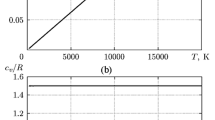Summary
A method is proposed for the simulation of weathering and aging of mixtures of organic components of similar polarity, e.g. gasolines. Semi-empirical equations are derived and tested which correlate the composition of samples after evaporation with the composition of the original material. In this way, changes in composition during partial evaporation of the liquid mixture can be predicted. In the context of forensic investigations this procedure can be helpful for tracing back the composition of the liquid remaining to that of the original unweathered liquid. To perform this simulation, the relative volatilities of the individual components in the mixture have to be known. These are determined by gas chromatographic retention data simultaneously with the concentrations of the volatile components. The paper evaluates the semi-empirical equations employed and discusses the influence of the simplifying assumptions introduced on the accuracy of the simulation.
Similar content being viewed by others
Abbreviations
- F:
-
error function
- Gi(Δt) :
-
transport function for component i in the gas phase in the evaporation experiment
- J1(ns) :
-
total interstage flow within cascades in a multistage distillation process
- N:
-
theoretical plate number of the distillation process
- Qi :
-
mass of component i
- R:
-
gas constant
- T:
-
temperature
- V:
-
volume of the phase indicated by superscript
- a:
-
parameter depending on the value of the transport function
- b:
-
number of independent equilibration and diffusion steps in the evaporation experiment
- b′:
-
parameter related to N in a distillation process
- d:
-
parameter depending on the value of the transport function
- k:
-
diffusivity related constant
- n:
-
number of components submitted to regression
- ns :
-
total number of moles in the still at a certain time
- Poi :
-
vapour pressure of the pure component i at a given temperature
- v:
-
average molar volume of the phase indicated
- x:
-
mole fraction
- α:
-
relative volatility
- γ:
-
activity coefficient of the indicated component in the liquid phase
- κ:
-
mass-distribution coefficient of the indicated component, capacity factor
- (g):
-
gas phase
- (L):
-
liquid phase
- (m):
-
mobile phase
- (s):
-
stationary phase
- (GC):
-
indicating GC experiment
- (v):
-
indicating evaporation experiment
- exptl:
-
value obtained by experiment
- calc:
-
calculated value
- i:
-
individual component in the mixture
- R:
-
reference component
- (o):
-
indicating time 0, i.e. at the beginning of evaporation
- (t):
-
indicating time t being elapsed after the start of the evaporation
- (Δt):
-
indicating a small time increment
- Qi (g) (o) :
-
mass of component i in the gas phase under equilibrium conditions at the beginning of the transport process
- Qi (L) (t) :
-
mass of component i in the liquid phase at time t
- xi (L) (o) :
-
mole fraction of i in the liquid remaining at the beginning of the distillation
- xi (L) (t) :
-
mole fraction of i in the liquid remaining at time t
References
U. Onken in Winnacker Kuechler „Chemische Technologie”, 4. Auflage, Bd. 1, Carl Hanser, Muenchen, Wien 1984; p. 180 ff.
D. Stoye, J. Doerfel, H. Rauch-Puntigam, E. Gemmer, H. Lehmann, W. Wilfinger in „Lacke und Loesungsmittel”, Verlag Chemie, Weinheim, New York 1979; p. 61 ff.
D. C. Mann, J. Forensic Sciences32, 606 and 616 (1987).
R. Hirz, J. Forensic Sciences29, 21 (1989).
R. Hirz, A. M. Rizzi, J. Forensic Science Society, in press.
J. R. Bowman, R. C. Briant, J. Ind. Eng. Chem.39, 745 (1947).
P. E. Porter, C. H. Deal, F. H. Stross, J. Am. Chem. Soc.78, 2999 (1956).
G. J. Pierotti, C. H. Deal, E. L. Derr, P. E. Porter, J. Am. Chem. Soc.78, 2989 (1956).
E. sz. Kováts, Helv. Chimia Acta41, 1915 (1958).
L. Sojak, J. Krupak, J. Rijks, Chromatographia7, 26 (1974).
F. Saura-Calixto, A. Garcia-Raso, P. M. Deya, J. Chromatogr. Sci.20, 7 (1982).
F. Saura-Calixto, A. Garcia-Raso, J. Canellas, J. Garcia-Raso, J. Chromatogr. Sci.21, 267 (1983).
D. T. Coker, British Occupational Hygiene Society Technical Guide Series, 1983, No. 2, 1.
Author information
Authors and Affiliations
Rights and permissions
About this article
Cite this article
Hirz, R., Rizzi, A.M. Simulation of concentration changes in complex volatile mixtures during evaporation by using gas chromatography. Chromatographia 31, 224–232 (1991). https://doi.org/10.1007/BF02275741
Received:
Revised:
Accepted:
Issue Date:
DOI: https://doi.org/10.1007/BF02275741




